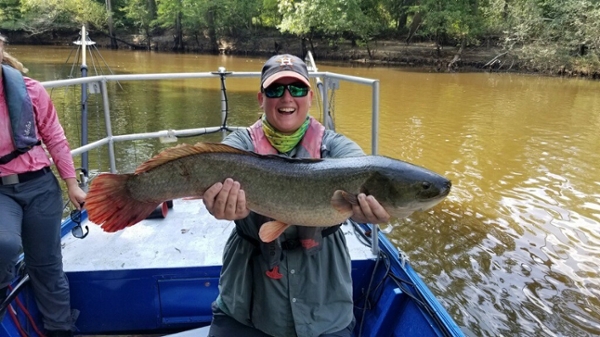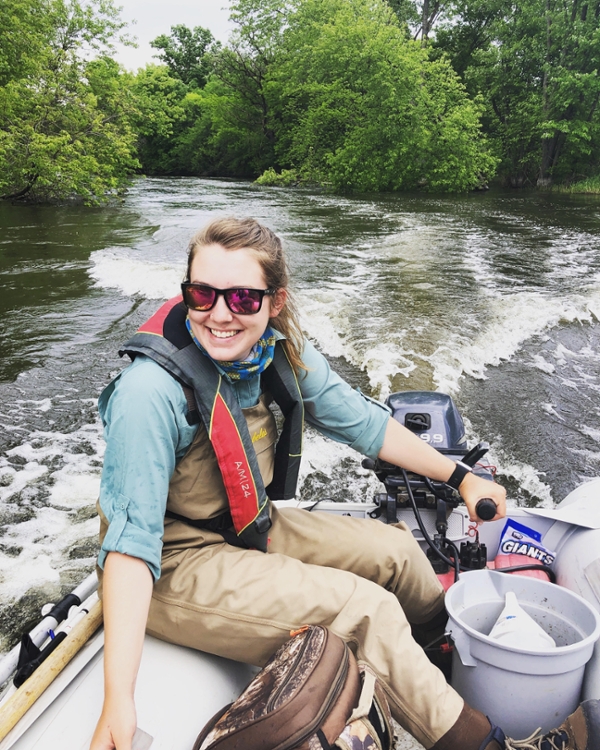Keeping Current: A&M-Galveston Marine Biology Department Staffer Studies Fish Species in Texas Rivers
October 23, 2019
Tweet
Texas A&M University at Galveston’s Sea Life Facility Manager and marine biology department lecturer Katie St. Clair smiles as she holds a large bowfin found in Big Cypress Creek. St. Clair traveled throughout Texas during the summer as part of the National Rivers and Stream Assessment (NRSA) project.
By Andréa Bolt, Marketing and Communications
Katie St. Clair’s eyes light up when she starts talking about fish. Bass, bowfin, catfish or trout, it doesn’t matter, she can go on in species-specific detail about every single one and got the opportunity to do just that this past summer.
St. Clair, Texas A&M University at Galveston’s Sea Life Facility Manager and a lecturer in the marine biology department, participated in the National Rivers and Streams Assessment (NRSA) to help conduct a nationwide survey of the conditions of the U.S.’s rivers and streams. The goal of the multi-year survey is to measure the health of our country’s waters, evaluate the efficacy of protection and restoration efforts and take preventative action to prevent pollution where necessary.
Together with the Environmental Institution of Houston (EIH), project experts were contracted through the Texas Commission on Environmental Quality for the large-scale project ultimately belonging to the United States Environmental Protection Agency (EPA).
As a fish taxonomist, a specialist in fish species, and a native Texan passionate about keeping her state’s natural resources as healthy as possible, St. Clair was a shoe-in. So, from late May through late August, she traveled all across the state taking measurements at over 40 different sites, including the Texas Panhandle and along the Rio Grande.
The group of researchers was particularly interested in measuring the condition of habitat along rivers and streams, studying algae, smaller aquatic animals such as insects and snails that usually serve as prey food for fish, bacteria levels in the water, type and abundance of fish species and contaminants in fish tissue.
St. Clair’s particular part in the study occurred when it came time to identify, measure and otherwise scientifically quantify the fish and to gather biological samples.
“We would introduce an electrical current into the water, which stuns and brings the fish to surface - it doesn’t kill them - and then ID, measure, note body condition, take what equated to a biopsy sample, then return them to the river,” she explained.
She said those biopsies are largely taken to test for heavy metals in the fish.
Though the self-described fish “nerd” was thrilled to see and handle so many native Texas fish species, she says that actually wasn’t her favorite part of the project.
“It was amazing to be able to experience some of these very pristine sites,” she said. “One of my favorite parts was exploring the state and also getting to interact with landowners. Texas landowners are some of the best and biggest stewards of our natural environment. They want to know what’s going with their rivers and streams and are very invested in conservation.”
St. Clair was also excited to be able to work alongside two A&M-Galveston graduates on the project. Zoe Cross ’18, acted as a field technician with the EIH to take part in the NRSA Texas survey. Cross also participated in the survey in a number of other states.
“This summer I traveled to Arizona, Minnesota, North and South Dakota for the EPA's National Rivers and Streams Assessment. My favorite part was spending eight days in the Grand Canyon to complete sites on the Colorado River. I'm so grateful that TAMUG gave me the hands-on experience I needed to find such an exciting job out in the field,” said Cross.
Additionally, St. Clair worked with Mandi Gordon ’07, a senior biologist with the EIH and A&M-Galveston marine biology graduate.
St. Clair, who teaches a mariculture class, said the project had many high points, but she also noted how important it was and is for her to stay up-to-date regarding what skills such environmental agencies are looking for in terms of teaching and curriculum.
“Experiences like this are great for me to stay knowledgeable about protocols and just where this ecological field is developing and then bringing that information back for our students and being able to share it with them so they have the best edge they can if they’re interested in career fields like this, and many of them are.”

Former Student Zoe Cross ’18 navigates a raft through a river in Minnesota as part of the National Rivers and Streams Assessment (NRSA) project.
###
Media contact:Marketing and Communications
a_bolt@tamug.edu
409.740.4929